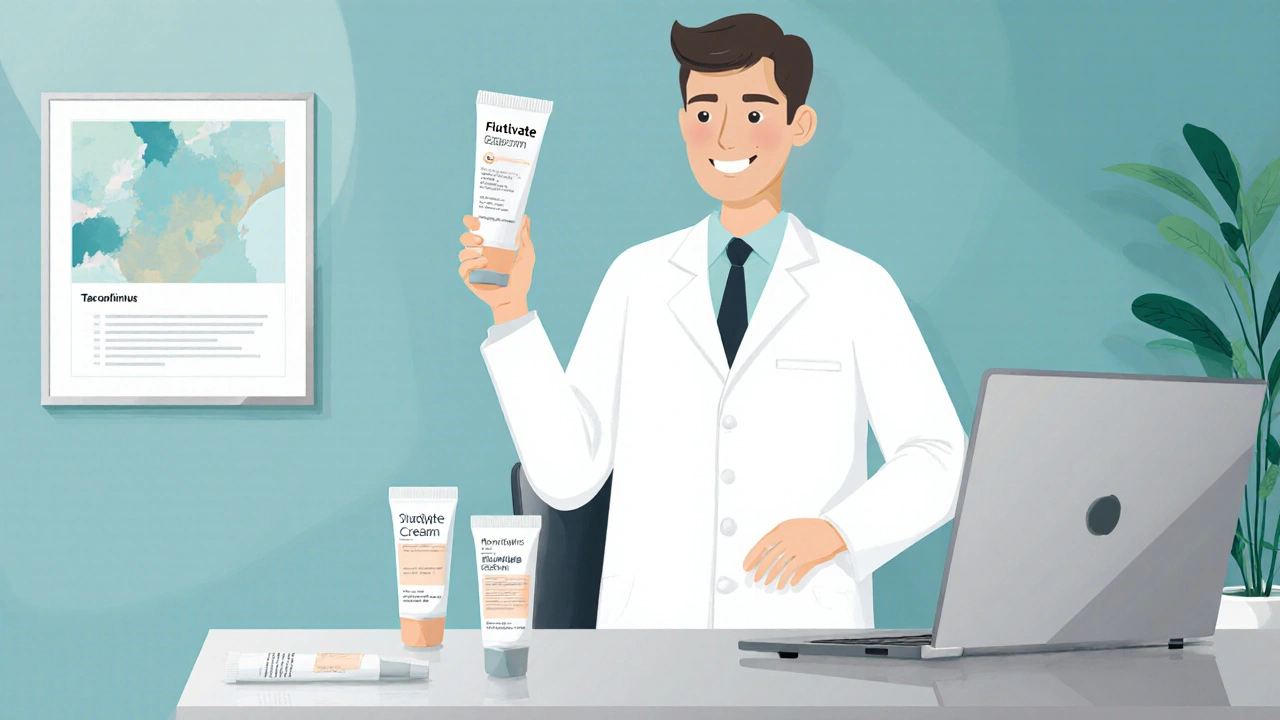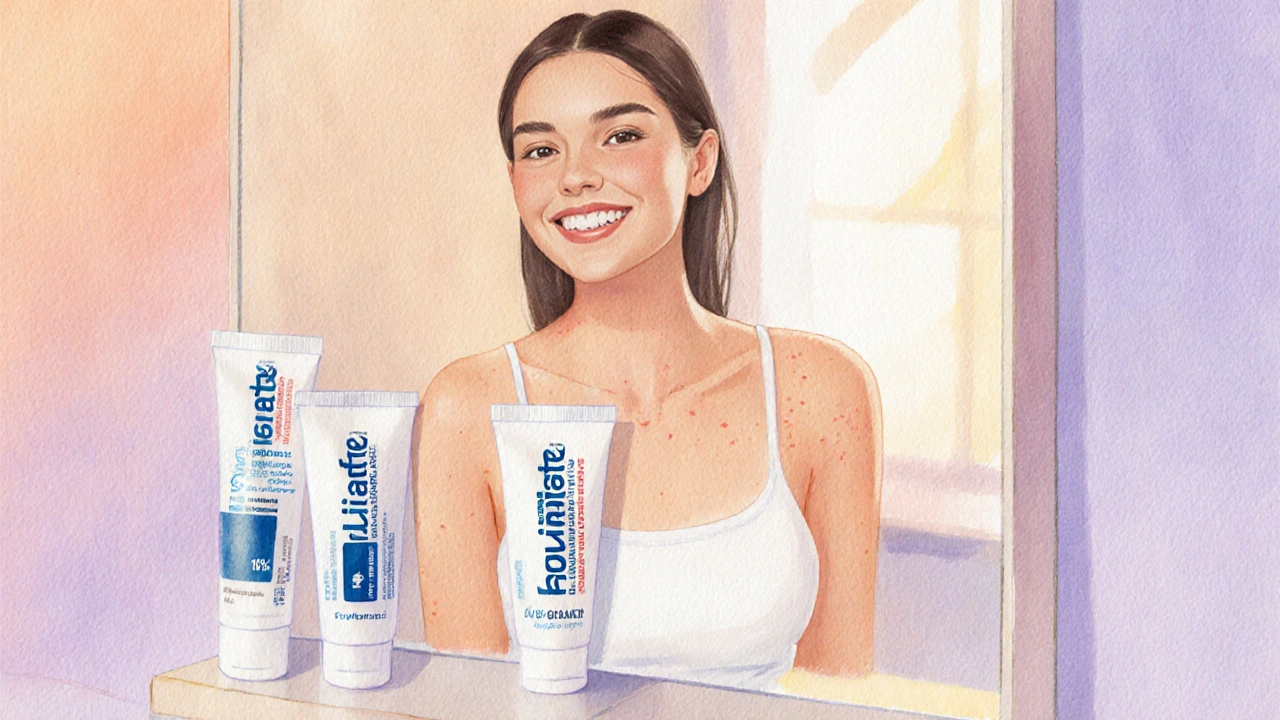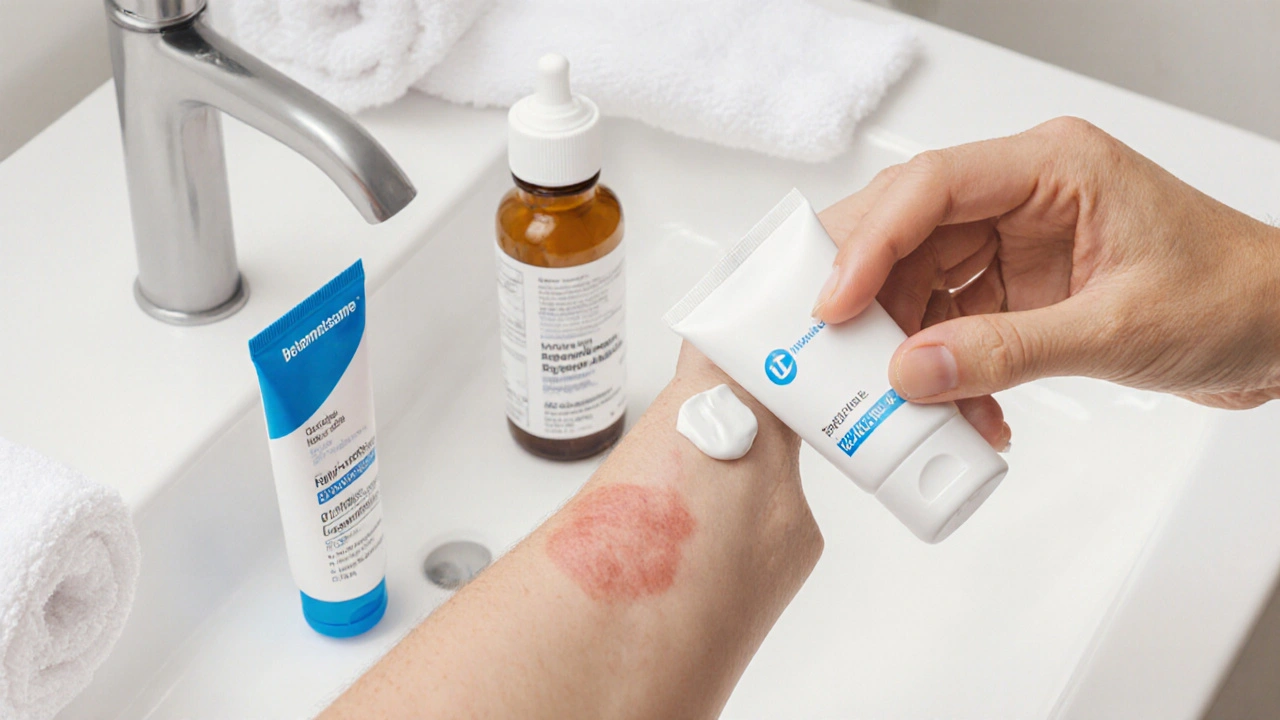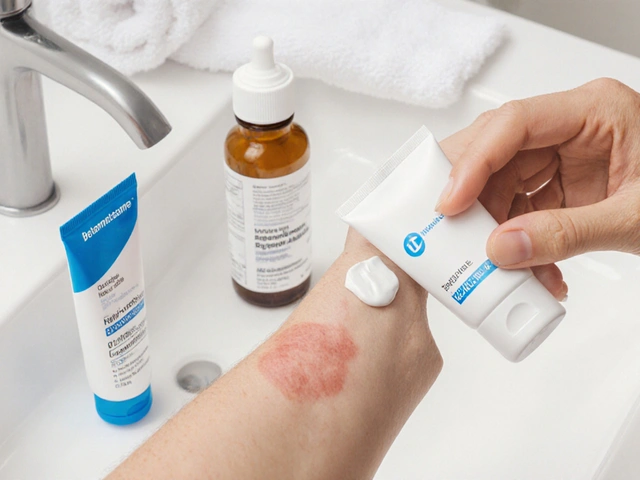Topical Steroid Comparison Tool
Recommended Treatment:
Treatment Comparison
When you’re dealing with itchy, inflamed skin, the first thing you look for is a cream that actually works without causing a new set of problems. Flutivate skin cream (containing fluticasone propionate) is a prescription‑strength steroid that many dermatologists recommend for eczema, psoriasis, and other inflammatory conditions. But is it the best choice for you, or are there cheaper or safer alternatives that deliver similar relief? This guide breaks down the key players, compares their strengths and drawbacks, and helps you decide which product fits your skin and lifestyle.
Key Takeaways
- Flutivate offers high potency with low systemic absorption, ideal for moderate‑to‑severe eczema.
- Hydrocortisone is the mildest over‑the‑counter option, great for flare‑ups on sensitive areas.
- Betamethasone and mometasone sit between mild and very strong steroids, balancing efficacy and risk.
- Non‑steroidal options like tacrolimus and crisaborole work without the thinning‑skin side effect but may be pricier.
- Cost, prescription status, and side‑effect profile are the three deciding factors for most users.
Understanding Flutivate Skin Cream
Flutivate is a prescription‑only topical corticosteroid that contains fluticasone propionate 0.05%. The active ingredient belongs to the class of medium‑to‑high potency steroids and works by suppressing the inflammatory cascade in the skin. Approved in the UK for eczema, psoriasis, and seborrhoeic dermatitis, Flutivate is applied once or twice daily to affected areas for up to two weeks, unless a specialist advises a longer course.
Key attributes of Flutivate:
- Potency: Medium‑high (equivalent to betamethasone valerate 0.1%).
- Systemic absorption: Low, thanks to the lipophilic nature of fluticasone.
- Prescription status: Requires NHS or private prescription.
- Typical cost (2025 UK): £15-£20 for a 30g tube.
Typical side effects include skin thinning with prolonged use, burning or stinging on first application, and possible hypopigmentation.
Topical Steroid Alternatives
Not everyone wants a steroid or can get a prescription. Below are the most common alternatives, each marked up for easy reference.
Hydrocortisone is an over‑the‑counter (OTC) low‑potency steroid available in 0.5% and 1% creams. It’s often the first line for mild eczema or diaper rash.
- Potency: Low (equivalent to classI).
- Cost: £2-£4 for a 30g tube.
- Side effects: Minimal when used short‑term.
Betamethasone (often sold as betamethasone valerate 0.1%) is a medium‑potency prescription steroid used for more resistant plaques.
- Potency: Medium‑high.
- Cost: £10-£14 for a 30g tube.
- Side effects: Skin atrophy with prolonged use; caution on face.
Mometasone furoate 0.1% is a medium‑potency steroid, popular for flexible dosing (once daily or twice daily).
- Potency: Medium‑high.
- Cost: £12-£16 for a 30g tube.
- Side effects: Similar to other medium‑potency steroids, with lower risk of systemic absorption.
Tacrolimus (brand Protopic) is a non‑steroidal immunomodulator available in 0.03% and 0.1% ointments. It’s prescribed for moderate‑to‑severe eczema when steroids are unsuitable.
- Mechanism: Inhibits T‑cell activation.
- Cost: £90-£120 for a 30g tube (private).
- Side effects: Burning sensation, possible increased skin infection risk.
Crisaborole (EUCRISA) is a phosphodiesterase‑4 inhibitor, marketed as a non‑steroidal cream for mild‑to‑moderate eczema.
- Potency: Non‑steroidal, mild anti‑inflammatory.
- Cost: £70-£80 for a 30g tube.
- Side effects: Mild stinging; no skin thinning.
Pimecrolimus (Elidel) works similarly to tacrolimus but is licensed for use on delicate areas like the face and flexures.
- Strength: 1% cream.
- Cost: £85-£110 for a 30g tube.
- Side effects: Burning, rare risk of lymphoma (theoretical).

Comparison Table: Key Attributes
| Product | Active Ingredient | Potency | Prescription? | Typical Cost (2025, UK) | Main Side Effects |
|---|---|---|---|---|---|
| Flutivate | Fluticasone propionate 0.05% | Medium‑high | Yes | £15-£20 | Skin thinning, burning |
| Hydrocortisone | Hydrocortisone 0.5% / 1% | Low | No | £2-£4 | Minimal |
| Betamethasone | Betamethasone valerate 0.1% | Medium‑high | Yes | £10-£14 | Atrophy, stretch marks |
| Mometasone | Mometasone furoate 0.1% | Medium‑high | Yes | £12-£16 | Skin thinning (less than betamethasone) |
| Tacrolimus | Tacrolimus 0.03% / 0.1% | Non‑steroidal | Yes | £90-£120 | Burning, infection risk |
| Crisaborole | Crisaborole 2% | Non‑steroidal | Yes (some OTC in EU) | £70-£80 | Mild stinging |
| Pimecrolimus | Pimecrolimus 1% | Non‑steroidal | Yes | £85-£110 | Burning, rare lymphoma concern |
How to Choose the Right Cream for Your Situation
Every skin condition is unique, but three practical questions usually guide the decision:
- How severe is the flare‑up? Mild patches often respond to hydrocortisone. Moderate‑to‑severe plaques may need a medium‑potency steroid like Flutivate, betamethasone, or mometasone. Extreme cases sometimes require a very‑high potency steroid (clobetasol) or a non‑steroidal immunomodulator.
- Where on the body is the issue? Thin‑skinned areas (face, neck, flexures) are more vulnerable to atrophy. In those zones, low‑potency steroids or non‑steroidal options (tacrolimus, pimecrolimus) are safer.
- What’s the budget and prescription access? OTC hydrocortisone is cheap and easy. Prescription steroids like Flutivate are modestly priced on the NHS, but private costs add up. Non‑steroidal creams can be pricey and may not be fully covered.
Match your answers to the table above and you’ll see which product aligns best.
Practical Tips for Using Topical Steroids Safely
- Start low, go slow: Apply a thin layer once daily for the first three days. If improvement is seen, you can increase to twice daily for a short period.
- Limit duration: Most guidelines advise no more than two weeks of continuous use for medium‑potency steroids, followed by a taper or a steroid‑free moisturizer.
- Use a barrier: Apply a fragrance‑free moisturizer after the steroid has been absorbed (about 20 minutes) to lock in moisture and reduce rebound itching.
- Watch for side effects: If you notice skin thinning, stretch marks, or a new rash, stop the product and consult a dermatologist.
- Consider rotation: Switching between a steroid and a non‑steroidal cream (e.g., tacrolimus at night) can keep inflammation under control while minimizing steroid exposure.
Real‑World Scenarios
Case 1 - A 30‑year‑old with chronic atopic dermatitis: The patient uses hydrocortisone for flare‑ups on the hands but gets recurrent patches on the elbows. Switching to Flutivate twice daily for two weeks, then moving to a nightly mometasone, gave rapid clearance without noticeable thinning after three months.
Case 2 - A 65‑year‑old with scalp psoriasis: High‑potency steroids caused irritation on the scalp. A regimen of weekly tacrolimus ointment combined with a gentle steroid‑free shampoo cleared plaques and avoided the risk of skin atrophy.
Case 3 - A teenager with facial eczema: Because the face is thin, the dermatologist recommended pimecrolimus 1% twice daily. The patient experienced minimal burning and saw improvement within two weeks, eliminating the need for any steroid.

When to See a Dermatologist
If any of the following apply, schedule a visit:
- Symptoms persist beyond two weeks despite appropriate topical treatment.
- Signs of infection (oozing, crusting, fever).
- Unclear diagnosis - especially if the rash could be fungal, bacterial, or allergic.
- Need for systemic therapy (oral steroids, biologics).
Frequently Asked Questions
Frequently Asked Questions
Can I use Flutivate on my face?
Flutivate is a medium‑high potency steroid, so it’s generally not recommended for the delicate skin of the face unless a dermatologist specifically directs its short‑term use. For facial eczema, low‑potency steroids or non‑steroidal options like pimecrolimus are safer.
How long does it take to see results with Flutivate?
Most patients notice a reduction in redness and itching within 48‑72hours. Full clearance of plaques can take 1-2weeks, depending on severity and adherence.
Is it safe to use Flutivate while pregnant?
Topical steroids are generally considered low risk in pregnancy, but the safest route is to use the lowest effective potency. Discuss with your obstetrician; they may suggest hydrocortisone or a short course of Flutivate only if benefits outweigh risks.
Can I combine Flutivate with a moisturizer?
Yes. Apply Flutivate first, let it absorb for about 20minutes, then follow with a fragrance‑free, ceramide‑rich moisturizer. This combo helps lock in moisture and reduces rebound itching.
Why is Flutivate more expensive than hydrocortisone?
Flutivate contains a newer, more potent active ingredient (fluticasone) and requires a prescription, which adds dispensing costs. Hydrocortisone is an older, low‑potency steroid sold over the counter, so its production and distribution are cheaper.
Bottom Line
If you need rapid relief for moderate eczema and can get a prescription, Flutivate offers a solid balance of potency and safety. For milder cases, hydrocortisone or low‑potency OTC options keep costs down. When skin thinning is a concern-especially on the face or folds-switching to non‑steroidal creams like tacrolimus, pimecrolimus, or crisaborole can provide control without the classic steroid side effects, albeit at a higher price.
Use the comparison table, weigh the three deciding factors (severity, location, budget), and you’ll land on the right product without trial‑and‑error guesswork.







Write a comment
Your email address will be restricted to us